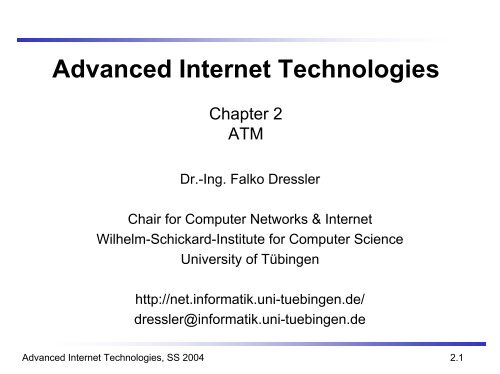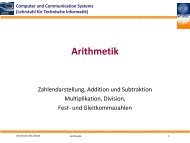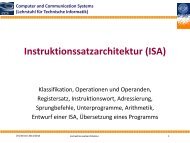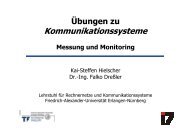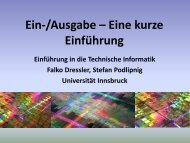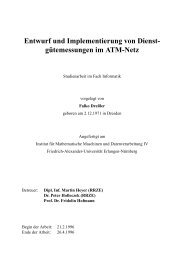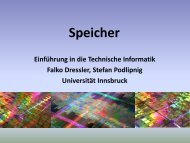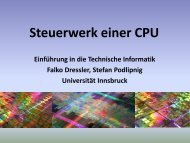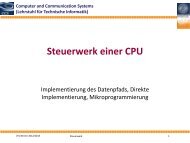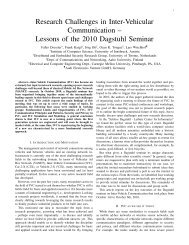Advanced Internet Technologies - Computer and Communication ...
Advanced Internet Technologies - Computer and Communication ...
Advanced Internet Technologies - Computer and Communication ...
Create successful ePaper yourself
Turn your PDF publications into a flip-book with our unique Google optimized e-Paper software.
<strong>Advanced</strong> <strong>Internet</strong> <strong>Technologies</strong><br />
Chapter 2<br />
ATM<br />
Dr.-Ing. Falko Dressler<br />
Chair for <strong>Computer</strong> Networks & <strong>Internet</strong><br />
Wilhelm-Schickard-Institute for <strong>Computer</strong> Science<br />
University of Tübingen<br />
http://net.informatik.uni-tuebingen.de/<br />
dressler@informatik.uni-tuebingen.de<br />
<strong>Advanced</strong> <strong>Internet</strong> <strong>Technologies</strong>, SS 2004 2.1
Basics of ATM<br />
Introduction<br />
Chapter 2<br />
ATM<br />
Reference Model<br />
Higher Layers<br />
Signaling, Routing<br />
IP over ATM<br />
LAN over ATM<br />
<strong>Advanced</strong> <strong>Internet</strong> <strong>Technologies</strong>, SS 2004 2.2
B-ISDN <strong>and</strong> ATM<br />
The goal of broadb<strong>and</strong> ISDN (1990)<br />
Worldwide consistently build high-performance network<br />
Transmission of data, audio, video<br />
St<strong>and</strong>ardization via ITU (CCITT)<br />
ATM (Asynchronous Transfer Mode) was selected as the base<br />
technology for B-ISDN<br />
Therefore, ATM is part of the ITU specification of B-ISDN<br />
<strong>Advanced</strong> <strong>Internet</strong> <strong>Technologies</strong>, SS 2004 2.3
Introduction<br />
ATM: Asynchronous Transfer Mode<br />
Based on st<strong>and</strong>ardized protocols<br />
Integrated technology for multiple services<br />
Data<br />
Speech / Audio<br />
Video<br />
Usable in LAN <strong>and</strong> WAN areas<br />
Highly scalable<br />
Support for different connection qualities -> Real-time!<br />
Employment of asynchronous time multiplex technologies for flexibility<br />
in support of various transmission b<strong>and</strong>widths<br />
<strong>Advanced</strong> <strong>Internet</strong> <strong>Technologies</strong>, SS 2004 2.4
Properties<br />
Data packets of fixed size, named cells<br />
ATM cells have a length of 53 byte (5 byte header, 48 byte payload)<br />
This allows a high speed processing including massive parallel hardware<br />
operations<br />
Connection oriented<br />
point-to-point<br />
point-to-multipoint<br />
Connections may have a fixed (reserved) b<strong>and</strong>width <strong>and</strong> guaranteed<br />
quality of service characteristics<br />
Centralized coordination of permissions to send (in contrast to token<br />
techniques or CSMA/CD)<br />
No shared medium<br />
Dedicated b<strong>and</strong>width<br />
<strong>Advanced</strong> <strong>Internet</strong> <strong>Technologies</strong>, SS 2004 2.5
St<strong>and</strong>ardization<br />
ITU-T: International Telecommunications Union – Telecommunications<br />
St<strong>and</strong>ards Section (formerly CCITT)<br />
http://www.itu.ch/<br />
ETSI: European Telecommunications St<strong>and</strong>ards Institute<br />
http://www.etsi.fr/<br />
ANSI: American National St<strong>and</strong>ards Institute<br />
http://web.ansi.org/<br />
ATM-Forum<br />
Development of industry st<strong>and</strong>ards allowing a fest development of new<br />
products<br />
http://www.atmforum.com/<br />
<strong>Advanced</strong> <strong>Internet</strong> <strong>Technologies</strong>, SS 2004 2.6
ATM Layer Model<br />
User plane: information flow between the layers<br />
Control plane: connection setup, maintenance <strong>and</strong> termination<br />
Management plane: meta-signaling <strong>and</strong> OAM information flow<br />
<strong>Advanced</strong> <strong>Internet</strong> <strong>Technologies</strong>, SS 2004 2.7
Physical Layer<br />
Physical medium sends <strong>and</strong> receives a bit stream<br />
Bit timing<br />
Transmission convergence<br />
The physical layer adopts the ATM cells received from the ATM layer<br />
to the bit stream required by the physical layer (cell coding)<br />
Direct cell transmission<br />
Cell adaptation to existing transmission frames<br />
PLCP based cell adaptation<br />
HEC generation<br />
Information flow to the management <strong>and</strong> to the supervision at the<br />
physical layer (OAM)<br />
<strong>Advanced</strong> <strong>Internet</strong> <strong>Technologies</strong>, SS 2004 2.8
Physical Layer II<br />
Transmission speeds<br />
PDH (Plesiochronous Digital Hierarchy)<br />
Europe: 2,048 Mbit/s, 8,448 Mbit/s, 34,368 Mbit/s, 139,264 Mbit/s<br />
USA: 1,544 Mbit/s, 6,312 Mbit/s, 44,736 Mbit/s, 254,176 Mbit/s<br />
SDH (Synchronous Digital Hierarchy)<br />
OC-3: 155,520 Mbit/s<br />
OC-12: 622,080 Mbit/s<br />
Today: OC-48, OC-192, …<br />
<strong>Advanced</strong> <strong>Internet</strong> <strong>Technologies</strong>, SS 2004 2.9
ATM Layer<br />
Transport of ATM cells between the communication end points<br />
Tasks of the user <strong>and</strong> control plane<br />
Connection setup, multiplexing/de-multiplexing <strong>and</strong> maintaining ATM<br />
connection<br />
Generation of ATM cell headers (but HEC)<br />
Negotiation of QoS parameters<br />
Traffic <strong>and</strong> overload control<br />
OAM cells (management plane)<br />
Meta-signaling<br />
<strong>Advanced</strong> <strong>Internet</strong> <strong>Technologies</strong>, SS 2004 2.10
ATM Cell Format<br />
53 Byte<br />
5 Byte Header<br />
48 Byte Payload<br />
<strong>Advanced</strong> <strong>Internet</strong> <strong>Technologies</strong>, SS 2004 2.11
ATM Cell Types<br />
UNI/NNI cells: data communication<br />
Transmission of user data<br />
Transmission of signaling data (connection setup, maintenance, tear down)<br />
VP/VC OAM cells (F4 <strong>and</strong> F5)<br />
Idle cells: decoupling of the cell rate at the sender <strong>and</strong> the available b<strong>and</strong>width<br />
of the transmission medium<br />
Empty cells: contain VPI/VCI but no payload<br />
OAM cells: contain control <strong>and</strong> service information<br />
Reserved VCI/VPI values<br />
Function VPI/VCI<br />
Meta signaling VCI=1, VPI=0<br />
ILMI VCI=16, VPI=0<br />
Point-to-point signaling VCI=5<br />
PNNI VCI=18, VPI=0<br />
….<br />
<strong>Advanced</strong> <strong>Internet</strong> <strong>Technologies</strong>, SS 2004 2.12
Virtual Channels<br />
ATM Connections<br />
2 Hierarchies: paths <strong>and</strong> channels<br />
Virtual Path<br />
Transmission Path<br />
<strong>Advanced</strong> <strong>Internet</strong> <strong>Technologies</strong>, SS 2004 2.13
Properties of ATM Connections<br />
Start <strong>and</strong> end at higher layer functions<br />
Have associated service parameters (e.g. cell loss ratio, latency)<br />
Negotiation of transmission parameters before a connection is set up<br />
(provision of QoS)<br />
Preservation of the transmission order<br />
Unidirectional or bidirectional<br />
Symmetric or asymmetric b<strong>and</strong>width<br />
Permanent<br />
PVC: Permanent Virtual Channel<br />
Dynamic<br />
SVC: Switched Virtual Channel<br />
Signaling: connection setup <strong>and</strong> tear down<br />
(ATM Forum: UNI 3.1, UNI 4.0)<br />
Routing Protocols (ATM-Forum: P-NNI)<br />
Addressing<br />
<strong>Advanced</strong> <strong>Internet</strong> <strong>Technologies</strong>, SS 2004 2.14
Traffic <strong>and</strong> Overload Control<br />
Traffic Management 4.0 (ATM Forum)<br />
Connection admission control<br />
Verification if connection setup would be possible<br />
User/network parameter control (UPC/NPC)<br />
Supervision of transmission b<strong>and</strong>width by setting a cell loss priority <strong>and</strong><br />
selectively discarding of cells<br />
Traffic shaping<br />
adjustment / smoothing of the transmission rate<br />
Early packet discard<br />
discarding of complete AAL PDUs if single cells are lost<br />
<strong>Advanced</strong> <strong>Internet</strong> <strong>Technologies</strong>, SS 2004 2.15
Call Admission Control<br />
Exchange of information during the connection setup<br />
Source traffic descriptor<br />
Peak cell rate (PCR): upper bound for the maximum cell transmission rate [c/s]<br />
Sustainable cell rate (SCR): upper bound for the average cell transmission rate<br />
[c/s]<br />
Maximum burst size (MBS): size of a buffer used for short bursts [c]<br />
Minimum cell rate (MC): lower bound for the cell transmission rate [c/s]<br />
Cell delay variation tolerance (CDVT): lower bound for the minimum<br />
distance between two cells<br />
(generated by multiplexing, OAM cells, …)<br />
QoS of the connection (QoS parameters)<br />
Successful completion of the CAC<br />
Traffic agreement is negotiated between the network <strong>and</strong> the end systems<br />
<strong>Advanced</strong> <strong>Internet</strong> <strong>Technologies</strong>, SS 2004 2.16
UPC/NPC<br />
Usage Parameter Control / Network Parameter Control<br />
Verification of<br />
Correctness of the VP/VC identifiers in the cell header<br />
Conformance of the cell stream (compliance with the negotiated traffic<br />
profile)<br />
Actions<br />
Cell passing<br />
Cell tagging (warning)<br />
Cell discarding (in overload situations)<br />
Generic cell rate algorithm (GCRA)<br />
For every cell, a theoretical arrival time (TAT) is calculated based on the<br />
assumption that the distance between all cells is equal<br />
If the actual arrival time corresponds with the TAT (taking a tolerance into<br />
account), the cell is conform<br />
<strong>Advanced</strong> <strong>Internet</strong> <strong>Technologies</strong>, SS 2004 2.17
UPC/NPC II<br />
UPC typically at the ingress of an ATM switch<br />
One or two leaky buckets depending on the service category<br />
<strong>Advanced</strong> <strong>Internet</strong> <strong>Technologies</strong>, SS 2004 2.18
Traffic Shaping<br />
Implementation using a leaky bucket<br />
Reduction of the burst size <strong>and</strong> removal of the cell delay variation (by<br />
increasing the delay)<br />
Important note: the order of the cells is not changed<br />
<strong>Advanced</strong> <strong>Internet</strong> <strong>Technologies</strong>, SS 2004 2.19
Early Packet Discard<br />
EPD buffer threshold to prevent overload situations<br />
If threshold is exceeded, complete AAL5 PDUs are dropped<br />
→ performance enhancement<br />
<strong>Advanced</strong> <strong>Internet</strong> <strong>Technologies</strong>, SS 2004 2.20
Quality of Service<br />
Parameter are negotiated at connection setup (ITU I.356/UNI4.0)<br />
Cell error ratio<br />
Severely errored blocks<br />
Cell loss ratio*<br />
Cell misinsertion ratio<br />
Cell transfer delay*<br />
Mean cell transfer delay<br />
Cell delay variation*<br />
*: currently unused<br />
Different classes (ATM-Forum)<br />
Constant bit-rate (CBR)<br />
Delay sensitive CBR cell stream<br />
Variable bit rate - real time (VBR-rt)<br />
Delay sensitive VBR cell stream<br />
Variable bit rate - non real time (VBR-nrt)<br />
Delay insensitive VBR cell stream<br />
Unspecified bit rate (UBR)<br />
Best effort<br />
Available bit rate (ABR)<br />
Dynamic b<strong>and</strong>width allocation if available<br />
<strong>Advanced</strong> <strong>Internet</strong> <strong>Technologies</strong>, SS 2004 2.21
Quality of Service II<br />
Attribute CBR VBR-rt VBR-nrt UBR ABR<br />
Traffic parameters<br />
PCR <strong>and</strong> CDVT(pcr)<br />
SCR, MBS, CDVT(scr)<br />
MCR<br />
QoS parameters<br />
Peak-peak CDVT<br />
maxCTD<br />
CLR<br />
Specified<br />
n/a<br />
n/a<br />
Specified<br />
Specified<br />
Specified<br />
Specified<br />
Specified<br />
n/a<br />
Specified<br />
Specified<br />
Specified<br />
Specified<br />
Specified<br />
<strong>Advanced</strong> <strong>Internet</strong> <strong>Technologies</strong>, SS 2004 2.22<br />
n/a<br />
Unspecified<br />
Unspecified<br />
Specified<br />
Specified<br />
n/a<br />
n/a<br />
Unspecified<br />
Unspecified<br />
Unspecified<br />
Specified<br />
n/a<br />
Specified<br />
Unspecified<br />
Unspecified<br />
Flow control<br />
Closed loop Unspecified Unspecified Unspecified Unspecified Specified
ATM Adaptation Layer<br />
AAL (ATM Adaptation Layer): mapping data structures between higher<br />
layers <strong>and</strong> ATM cells<br />
Criteria:<br />
Time constraints<br />
Bit rate (constant, variable)<br />
Connection type (connection oriented / connection less)<br />
Convergence Sublayer (CS)<br />
Building CS-PDUs out of an application generated byte stream<br />
Segmentation <strong>and</strong> Reassembly Sublayer (SAR)<br />
Convert CS-PDUs into 48 byte fragments which fit in the payload of ATM cells<br />
<strong>Advanced</strong> <strong>Internet</strong> <strong>Technologies</strong>, SS 2004 2.23
ATM Adaptation Layer II<br />
<strong>Advanced</strong> <strong>Internet</strong> <strong>Technologies</strong>, SS 2004 2.24
ATM Adaptation Layer III<br />
AAL0: “native” ATM<br />
AAL1: constant bit rate (circuit emulation)<br />
AAL2: transmission of data streams with variable bit rates <strong>and</strong> well defined<br />
time constraints between sender <strong>and</strong> receiver<br />
AAL3/4: Variable bit rate without any time constraints<br />
AAL5: simplified AAL3/4 (no multiplexing of cells)<br />
SAAL: Signaling<br />
<strong>Advanced</strong> <strong>Internet</strong> <strong>Technologies</strong>, SS 2004 2.25
Convergence Sublayer<br />
Common part: to add / to remove header <strong>and</strong> trailer<br />
Unreliable transmission of data packets of variable length<br />
Connection setup between two CPCS end points<br />
Preservation of the order within a single CPCS connection<br />
Error detection <strong>and</strong> h<strong>and</strong>ling<br />
H<strong>and</strong>ling of overload information<br />
H<strong>and</strong>ling of cell loss priorities<br />
Dropping of incomplete CPCS PDUs<br />
Service specific:<br />
Q.SAAL (SSCS: specification for signaling channels)<br />
<strong>Advanced</strong> <strong>Internet</strong> <strong>Technologies</strong>, SS 2004 2.26
Segmentation <strong>and</strong> Reassembly Sublyaer<br />
Identification of the next SAP PDU to transmit<br />
PTI informs about start <strong>and</strong> end of a SAR PDU<br />
H<strong>and</strong>ling of overload<br />
H<strong>and</strong>ling of cell loss priorities<br />
Check for ordering of SAR PDUs<br />
<strong>Advanced</strong> <strong>Internet</strong> <strong>Technologies</strong>, SS 2004 2.27
SAAL<br />
SAAL: Adaptation layer for signaling<br />
meta signaling<br />
signaling AAL<br />
ITU Q.2100<br />
Offers a reliable service for the higher layer signaling (Q.2931)<br />
Q.2931 has no error correction mechanisms<br />
SSCS sublayer: realizes SSCOP protocol (Service Specific<br />
Connection Oriented Protocol)<br />
Sequence continuity<br />
Error correction, retransmission<br />
Flow control<br />
Keep alive<br />
Connection control<br />
Exchange of status information between sender <strong>and</strong> receiver<br />
<strong>Advanced</strong> <strong>Internet</strong> <strong>Technologies</strong>, SS 2004 2.28
Operation, Administration <strong>and</strong> Maintenance<br />
Information flow for management <strong>and</strong> control<br />
Cells can be identified by the PT field<br />
Error control <strong>and</strong> localization<br />
Performance control<br />
5 hierarchies: F1-F5<br />
Physical layer: F1-F3<br />
SDH encoding: F1, F2: section overhead, F3: path overhead<br />
PDH encoding: using PDH internal structures<br />
Indication of unavailability state, transport of defect information to the<br />
end system, MUX problems<br />
ATM layer: F4, F5<br />
Fault management<br />
Transmission of defect information in both directions<br />
– AIS - Alarm Indication Signal: sent upstream to indicate downstream failures<br />
– RDI - Remote Indication Signal: sent downstream to indicate upstream failures<br />
Continuity check<br />
Loopback cells: monitoring, fault localization<br />
Performance management<br />
<strong>Advanced</strong> <strong>Internet</strong> <strong>Technologies</strong>, SS 2004 2.29
ATM Components<br />
ATM Hosts<br />
ATM Switches<br />
ATM Edge Devices<br />
Interconnection of ATM networks <strong>and</strong> non-ATM networks<br />
ATM Interfaces (public/private)<br />
UNI (User Network Interface): defines protocols for the communication between<br />
hosts <strong>and</strong> switches<br />
NNI (Network to Network Interface): defines the interface between two network<br />
components<br />
<strong>Advanced</strong> <strong>Internet</strong> <strong>Technologies</strong>, SS 2004 2.30
Higher Layers<br />
Signaling, Routing<br />
UNI – User Network Interface<br />
PNNI - Private Network-to-Network Interface<br />
ILMI - Integrated Local Management Interface<br />
<strong>Advanced</strong> <strong>Internet</strong> <strong>Technologies</strong>, SS 2004 2.31
User Network Interface – Connection Setup<br />
Host A: specification of b<strong>and</strong>width, QoS <strong>and</strong> destination address<br />
Within the network:<br />
Verification of the available resources<br />
Acceptance / rejection of the request<br />
Reservation of the required resources<br />
Maintenance of the routing tables<br />
Host B: acceptance / rejection of the connection request<br />
<strong>Advanced</strong> <strong>Internet</strong> <strong>Technologies</strong>, SS 2004 2.32
User Network Interface – Connection Release<br />
Host A: connection release message<br />
Within the network:<br />
Release of resources belonging to the connection<br />
Acknowledgement of the connection release message<br />
Host B: acknowledgement of the connection release message<br />
<strong>Advanced</strong> <strong>Internet</strong> <strong>Technologies</strong>, SS 2004 2.33
User Network Interface III<br />
ATM point-to-multipoint connections<br />
Extensions in UNI 4.0 Signaling<br />
Multicast (leaf initiated join)<br />
Frame discard<br />
Signaling of more QoS parameters (CLR, meanCTD, maxCTD, CDV, ....)<br />
<strong>Advanced</strong> <strong>Internet</strong> <strong>Technologies</strong>, SS 2004 2.34
Private Network-to-Network Interface Protocol<br />
P-NNI: also known as Private Network Node Interface Protocol<br />
Setup of SVCs in networks with NSAP addressing in a multivendor<br />
environment<br />
Hierarchical routing structure, similar to OSPF<br />
Using topology <strong>and</strong> resource information to setup paths<br />
Phase 0: Inter-Switch Signaling Protocol (IISP)<br />
Signaling protocol for the communication between ATM switches<br />
(administratively configurable address prefixes)<br />
Phase 1:<br />
QoS support<br />
scalability <strong>and</strong> reachability<br />
Signaling is based on UNI3.1/4.0 with some extensions<br />
<strong>Advanced</strong> <strong>Internet</strong> <strong>Technologies</strong>, SS 2004 2.35
P-NNI - QoS<br />
CAC (connection admission control)<br />
Admission control at each node along the path<br />
Topology state protocol<br />
GCAC (generic CAC)<br />
Determination of the shortest path over all nodes which comply with the<br />
ABR <strong>and</strong> CLR<br />
Additionally, the path is versified using the QoS requirements (CDV, …)<br />
Source node creates a “Designated Transit List“ containing the complete<br />
route<br />
Cranback: possibility for a rollback<br />
<strong>Advanced</strong> <strong>Internet</strong> <strong>Technologies</strong>, SS 2004 2.36
P-NNI - Hierarchy<br />
Scalability: hierarchical routing protocol<br />
Summary of the reachability information at each hierarchy<br />
Identification using NSAP addresses<br />
Problems:<br />
internetworking with<br />
other networks<br />
Complexity in route<br />
aggregation<br />
<strong>Advanced</strong> <strong>Internet</strong> <strong>Technologies</strong>, SS 2004 2.37
Integrated Local Management Interface<br />
Protocol for the bidirectional exchange of management information<br />
Monitoring of systems<br />
Management of systems<br />
Using SNMP (simple network management protocol) for the<br />
communication (without UDP/IP addressing)<br />
Fundamentals: data base (ATM-UNI-MIB) with well defined comm<strong>and</strong>s<br />
for accessing the data base: AAL encapsulated SNMP messages,<br />
community name ILMI<br />
<strong>Advanced</strong> <strong>Internet</strong> <strong>Technologies</strong>, SS 2004 2.38
ILMI - Address Registration<br />
Bidirectional address registration<br />
Dynamic exchange of address information between end systems <strong>and</strong><br />
the network at the UNI<br />
The ATM host informs the switch about its ESI address<br />
The ATM switch provides the address prefix to the host<br />
Protocol for automatic address registration<br />
Benefits:<br />
There is no need to configure the prefix at each host<br />
There is no need for an additional address resolution protocol in the<br />
switches (all hosts register first)<br />
<strong>Advanced</strong> <strong>Internet</strong> <strong>Technologies</strong>, SS 2004 2.39
Applications<br />
Multimedia<br />
Video over ATM<br />
Benefits:<br />
guaranteed QoS parameters<br />
Low latency<br />
Resource sharing between multiple applications<br />
Drawbacks:<br />
Complexity in the maintenance of ATM networks<br />
Examples:<br />
M-JPEG codecs: 15Mbit/s, TV quality<br />
MPEG2 codecs: 3-40Mbit/s, DVD up to studio quality<br />
Lossless SDI: 270Mbit/s, uncompressed studio signals<br />
IP/LAN over ATM<br />
Classical IP, MPOA<br />
LAN Emulation<br />
<strong>Advanced</strong> <strong>Internet</strong> <strong>Technologies</strong>, SS 2004 2.40
Multiprotocol Encapsulation over AAL5 (RFC2684)<br />
RFC2684<br />
LLC/SNAP encapsulation<br />
LLC data packets are encapsulated into AAL5 CPCS PDUs<br />
Transmission of a complete data stream in a single VC<br />
A special header informs about the encapsulated protocol<br />
All protocols based on Ethernet, FDDI, … can be transported<br />
VC based multiplexing<br />
<strong>Communication</strong> end point in layer 3<br />
Avoidance of special LLC headers by using separate VCs for each<br />
protocol<br />
More efficient than LLC encapsulation<br />
<strong>Advanced</strong> <strong>Internet</strong> <strong>Technologies</strong>, SS 2004 2.41
Classical IP<br />
Specification of a complete IP implementation for ATM<br />
Allows unicast communication only<br />
Very efficient<br />
Support for large MTU sizes<br />
Direct encapsulation of IP packets into AAL PDUs<br />
LIS: logical IP subnet<br />
ATMARP/InATMARP: protocol similar to ARP to resolve IP to ATM addresses<br />
InATMARP functions are provided by an ATMARP server<br />
There must be an ATMARP server in each LIS<br />
<strong>Advanced</strong> <strong>Internet</strong> <strong>Technologies</strong>, SS 2004 2.42
Classical IP II<br />
Each ARP client must register its IP/ATM address information at the<br />
ATMARP server or request an IP address from the ATMARP server<br />
<strong>Advanced</strong> <strong>Internet</strong> <strong>Technologies</strong>, SS 2004 2.43
LANE<br />
LAN Emulation: connecting LANs over ATM networks<br />
The properties of ATM are completely hidden<br />
Complete emulation of the LAN MAC layer<br />
Thus, no need to modify existing LAN software<br />
But, no special ATM features can be used, e.g. QoS<br />
Provisioning of a special broadcast mechanism, which is also used for<br />
multicast<br />
Translation of MAC to ATM addresses<br />
Transmission of LAN packets using AAL5 PDUs<br />
Modules:<br />
LANE client (LEC)<br />
LANE server (LES)<br />
LANE configuration server (LECS)<br />
Broadcast <strong>and</strong> unknown server (BUS)<br />
<strong>Advanced</strong> <strong>Internet</strong> <strong>Technologies</strong>, SS 2004 2.44
LANE II<br />
LEC (LANE client)<br />
Control functions<br />
Data exchange using the ATM interface<br />
Interface to the application as a st<strong>and</strong>ard LAN MAC interface<br />
LES (LANE server)<br />
Control <strong>and</strong> maintenance of an E-LAN (emulated LAN)<br />
Registration of LECs<br />
Mapping of MAC to ATM addresses<br />
BUS (broadcast <strong>and</strong> unknown server)<br />
Delivery of broadcast, multicast <strong>and</strong> unknown packets received from any<br />
LANE client<br />
All packets with a broadcast or multicast address<br />
Packets which cannot be delivered directly, e.g. because the<br />
corresponding ATM address cannot be resolved<br />
Sequential processing of the single messages (AAL5 does not allow the<br />
change of the order of PDUs)<br />
<strong>Advanced</strong> <strong>Internet</strong> <strong>Technologies</strong>, SS 2004 2.45
LANE III<br />
LECS (LANE configuration server)<br />
Management of the different emulated LANs <strong>and</strong> the associated LANE<br />
servers<br />
Configuration database allowing a LANE client to find the appropriate<br />
LANE server for a specific emulated LAN<br />
LECS address<br />
Statically configured in LES <strong>and</strong> LEC<br />
Well known address<br />
via ILMI<br />
<strong>Advanced</strong> <strong>Internet</strong> <strong>Technologies</strong>, SS 2004 2.46
LANE IV<br />
<strong>Advanced</strong> <strong>Internet</strong> <strong>Technologies</strong>, SS 2004 2.47


